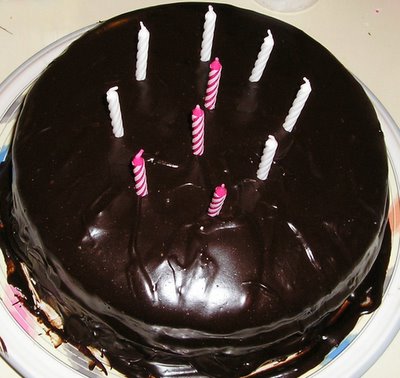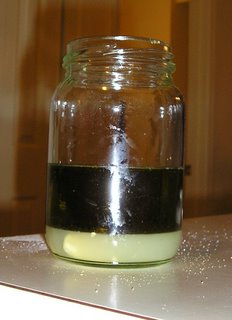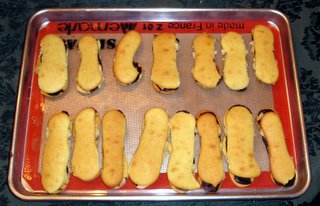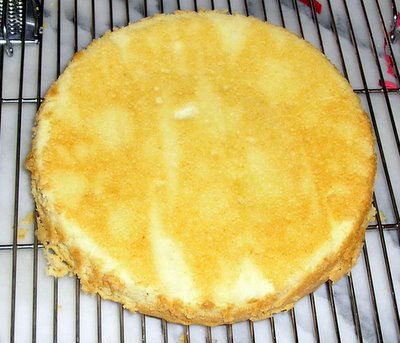Blood Orange Cake

February, known in the anapestic household, with much less exaggeration than we usually employ, as le mois des mille gateaux, is drawing to a close with the tenth birthday (yesterday) of L. She was, in fact, born either seven or eight minutes after midnight. I wish I could remember whether it was seven or eight minutes, but every year I ask, and every year I promptly forget the answer. In any case, she always makes a big deal of the fact that her birthday has actually really happened before the cake is cut. A., by contrast, squeaked in a minute ahead of her due date at 11:59 pm (fortunately, the nurse was keeping an eye on the clock; we were kind of busy with other matters), and L. is always careful to point out that when we're cutting A.'s cake, A. is not really as old as the number of candles. As sibling conflicts go, I reckon this one is pretty mild.
L. was unable or unwilling to articulate a preference for either her birthday dinner (which was carry out from her favorite Chinese restaurant; it's busy season, after all, and V.'s in Bosnia, and I barely have time to load the dishwasher) or her birthday cake. When A. and I were in Trader Joe's a couple of days ago, however, I happened upon some bags of blood oranges, and I decided that an orange cake was the way to go. I decided to fill and frost it with ganache. The cake itself is fairly light, and I figured the dark chocolate would contrast nicely with it.
 The cake is also pink (from the juice of the blood oranges), so I suppose that makes it a good choice for Valentine's Day. I am aware that Valentine's Day has already passed, but as it would not occur to me to make a cake for Valentine's Day, and, if making such a cake had occurred to me, it would certainly not have occurred to me to make a pink cake, it is hardly surprising that I made this discovery after it was already too late to do something that I wouldn't have done in any case. (I'm currently pitching to CBS a new series, Survivor: Run-on Sentences, in which the contestants will have to parse a series of my blog entries in order to get immunity. At the end of each episode, the host will say, "The tribe has spoken. We have no idea what they said.") It's a very light pink, though. I suppose that if I wanted to play up its pinkness, I'd frost it with a bright white icing. I can't imagine why I'd want to play up its pinkness, though. I'm kind of hoping no one will notice, but there must be people who'd appreciate a pink cake. Chacun a son gout, I reckon.
The cake is also pink (from the juice of the blood oranges), so I suppose that makes it a good choice for Valentine's Day. I am aware that Valentine's Day has already passed, but as it would not occur to me to make a cake for Valentine's Day, and, if making such a cake had occurred to me, it would certainly not have occurred to me to make a pink cake, it is hardly surprising that I made this discovery after it was already too late to do something that I wouldn't have done in any case. (I'm currently pitching to CBS a new series, Survivor: Run-on Sentences, in which the contestants will have to parse a series of my blog entries in order to get immunity. At the end of each episode, the host will say, "The tribe has spoken. We have no idea what they said.") It's a very light pink, though. I suppose that if I wanted to play up its pinkness, I'd frost it with a bright white icing. I can't imagine why I'd want to play up its pinkness, though. I'm kind of hoping no one will notice, but there must be people who'd appreciate a pink cake. Chacun a son gout, I reckon.Thursday night, when I was on the way home from the office (at 8:45) and I had to stop in at the supermarket to pick up some ingredients and supplies, I reasoned that since I'd made a fairly big deal -- in a recent post -- of not using cake flour because I never had any because I was afraid of having too much, I could be entirely sure that if I bought a box, it would be the only box in the pantry. Also, having said that cake flour is unnecessary, I could avoid what appears to be my fear of consistency by going with the cake flour. Finally while the last two cakes I made were completely delicious, I thought the texture was somewhat unrefined, and while I'm clearly the only one who noticed, there didn't seem to be any good reason not to use cake flour to get a superior texture. (I still think, though, that for chocolate cakes or cakes that have a lot of nuts or other add-ins, all purpose flour is at least as good; you don't necessarily want those cakes to be light to the point of etherealness.)
This recipe is adapted from a recipe in The Cake Bible. The original recipe calls for no orange flavoring and uses only egg yolks (six of them). Using only egg yolks would obviously give a substantially different result, but I very much like the cake I get with the whole eggs, and it's nice not to have to beat and fold in egg whites when you're not starting a cake until after 10 pm.
Blood Orange Cake
3 blood oranges
10.5 ounces sugar
1 cup milk
3 eggs
2 t. vanilla extract
10.5 ounces cake flour
4 t. baking powder
12 ounces butter, softened
Triple sec
Ganache (recipe follows)
Preheat your oven to 350 degrees. Grease two nine-inch layer pans, line the bottoms with wax or parchment paper*, then grease the paper. Flour the greased pans.
Remove the zest from the blood oranges. Put the zest and the sugar in a food processor and process until utterly pulverized. Squeeze the juice from the oranges. Strain it into a bowl or measuring cup and microwave on high for about three minutes, or until it is reduced and syrupy. Put in the freezer for three or four minutes to cool. Don't forget that it's in there.
In a bowl, mix the eggs, 1/4 cup of the milk, and the vanilla extract.
Put the cake flour, baking powder, and zest-infused sugar into the bowl of your stand mixer. Add the whisk attachment, and mix on medium for about a minute. Add the butter and mix for half a minute or so, then add the remaining 3/4 cup of milk, mix for a few seconds on low, then mix on medium for 3 minutes. Scrape down the sides of the bowl. With the mixer running on low, add the reduced blood orange juice. Then with the mixer still running, add about a third of the egg mixture. Do this last step two more times, waiting for the previous addition to become well incorporated each time.
Divide the batter between the pans, then bake for 30 to 35 minutes, or until the cake springs back when pressed and a pick inserted in the middle comes out clean.
Let the cakes cool in the pans for fifteen minutes, then invert onto cooling racks, remove the pans, and let cool completely.
Split each layer in half. Put one of the half layers on your cake plate and sprinkle it with Triple Sec. Pour a dollop of ganache onto the cake and spread it into a thin layer. Add another disk of cake and repeat the process. When you get the last layer of cake onto your stack, sprinkle it with Triple Sec, then pour ganache over the top and let it flow down the sides.
If you work quickly with a rubber scraper or spatula, you can spread the ganache around the sides without harming the sheen, but it's best if you don't touch the top.
*Parchment paper is slightly superior for lining cake pans, but the waxed paper works pretty well and is a great deal cheaper. If I could have found my roll of brown paper, I'd have used that. The main difference between waxed and parchment paper is that with parchment paper, the paper releases from the pan first, and with waxed paper, the cake releases from the paper first. You get a slightly better bottom crust with the parchment paper, but with the waxed paper, you get a very thin layer of cake crumbs on the waxed paper, and you can scrape this up with your fingers and eat it. Also, the waxed paper tends to be narrower than the parchment paper, and you waste less of it when you line a pan that is less than twelve inches in diameter. In a perfect world, someone would market precut rounds of parchment paper at a not wholly unreasonable price, but it has been frequently opined that we don't live in a perfect world, and that sentiment is extremely difficult to argue with.
I cannot claim to be any sort of expert on blood oranges, especially since this is the first time I've ever used any. The ones I bought were significantly smaller than regular oranges, perhaps the size of a lacrosse ball. You could easily make the recipe with regular oranges and substitute one big orange. Or perhaps the zest of two oranges and the juice of one. More orange zest is almost always better. Of course, if you do that, your cake won't be pink, but who wants pink cake? Peter Sellers? Steve Martin? (Though judging from the reviews, I'd guess maybe not Steve Martin.)
 I'm not sure how sensitive this cake recipe is. I suspect that it's fairly robust and that you could measure your flour and sugar by volume without any real fear. I'm very fond of my
I'm not sure how sensitive this cake recipe is. I suspect that it's fairly robust and that you could measure your flour and sugar by volume without any real fear. I'm very fond of my The ganache that I made (and which was otherwise awesome) was probably too intense for this somewhat delicate cake. My chocolate buttercream might have been a better choice, or I could simply have used a less intense bittersweet chocolate. I used the Trader Joe's 72% chocolate, which I adore, but which is really too strong for both this cake and the tastes of a ten-year-old child, even mine. As it happens, however, the addition of a scoop of vanilla ice cream deintensifies the dark chocolate and is not a particularly hard sell to L., so she was thrilled with the end result, especially since she managed to extinguish all her candles with one breath.
Ganache
1.25 cups heavy cream
500g dark chocolate, chopped
2 T. orange liqueur
Put the heavy cream in a four-cup measure and microwave on high for two minutes. Add the chocolate and the orange liqueur and stir until smooth. Let the mixture cool to just slightly warmer than lukewarm, and beat with a hand mixer for two minutes, or until lukewarm. Use immediately.
You don't have to use either the microwave or a hand mixer, of course. You can heat the cream in a saucepan until it's simmering, then remove it from the heat and add the chocolate and liqueur and stir until smooth, then you can pour it into the bowl of your stand mixer and beat it with the whisk attachment. The microwave and hand mixer are very convenient, however, and you will end up with fewer dishes to wash.
Instead of using this ganache to fill and frost a cake, you could, after beating the ganache with the mixer, cover it with plastic wrap, put it in the refrigerator for a couple of hours, take it out, form it into small balls, and roll the balls in cocoa. You'd have truffles. You'd have a lot of truffles. There are worse problems to have, believe me.







